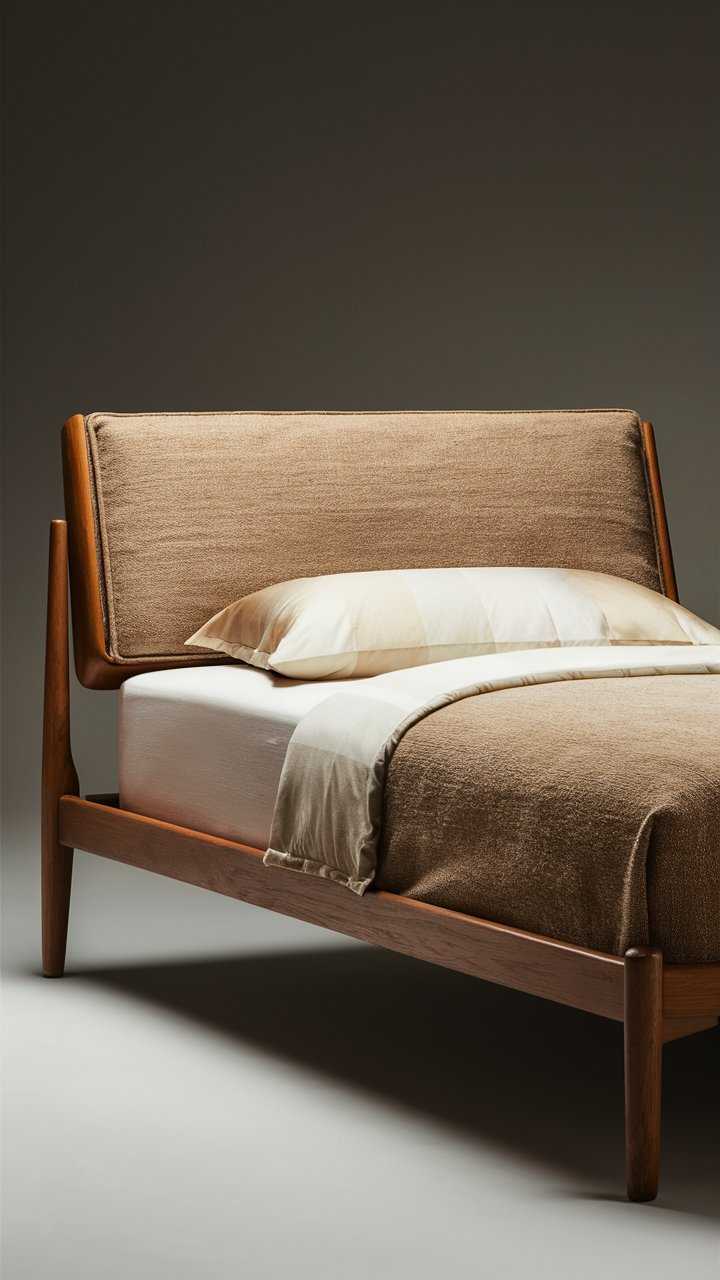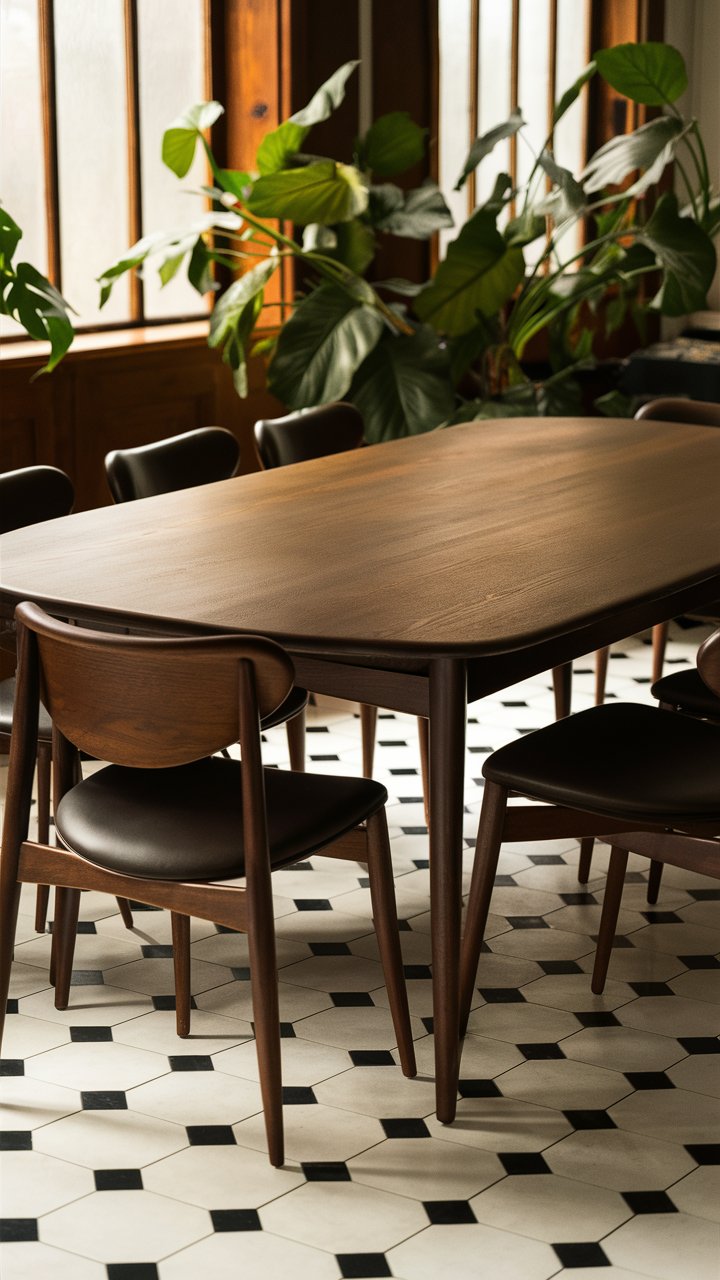Mid Century Modern House: Timeless Design & Style
The mid century modern house style started after World War II. It’s known for its clean lines and simple look. These homes blend well with nature and focus on living simply.
They have open floor plans, big windows, and sliding doors. These features make the inside and outside feel connected.
Builders used new materials like steel, stone, and timber. This led to homes with unique shapes and lots of natural light. The design focuses on being useful, simple, and in tune with nature. It’s a style that still inspires many today.

Key Takeaways
- Mid century modern houses are characterized by clean lines, minimalist aesthetics, and seamless integration with nature.
- Open floor plans, large windows, and sliding glass doors blur the boundaries between indoor and outdoor living.
- Innovative use of materials like steel, stone, and timber allow for unique, geometric architectural forms.
- The mid century modern style emphasizes functionality, simplicity, and harmonious integration with the surrounding environment.
- This iconic design movement has had a lasting impact on architecture and interior design.
Origins and Influences of Mid-Century Modern Style
After World War II, a new era began, filled with hope and a wish for change. The need for homes grew as soldiers came back and started families. Architects and designers like Frank Lloyd Wright, Richard Neutra, and Charles and Ray Eames were key in creating the mid century modern look.
These leaders of the origins of mid century modern used new technology and moved away from old European styles. Their work set the stage for the mid century modern style we admire today.
Post-War Era and Housing Demand
After World War II, there was a big need for homes as soldiers returned and started families. This led to a desire for homes that were both beautiful and practical. Mid century modern architects answered by designing homes that met the needs of modern families.
Pioneers: Frank Lloyd Wright, Richard Neutra, Charles and Ray Eames
Designers like Frank Lloyd Wright, Richard Neutra, and the Eames duo were vital in shaping mid century modern style. They focused on clean lines, open spaces, and blending with nature. These features became key to the style.
“The mother art is architecture. Without it, man has no place to live.”
– Frank Lloyd Wright
These mid century modern architects broke the mold, making spaces that were both useful and beautiful. Their work helped make mid century modern style popular and lasting.
Defining Features of Mid-Century Modern Houses
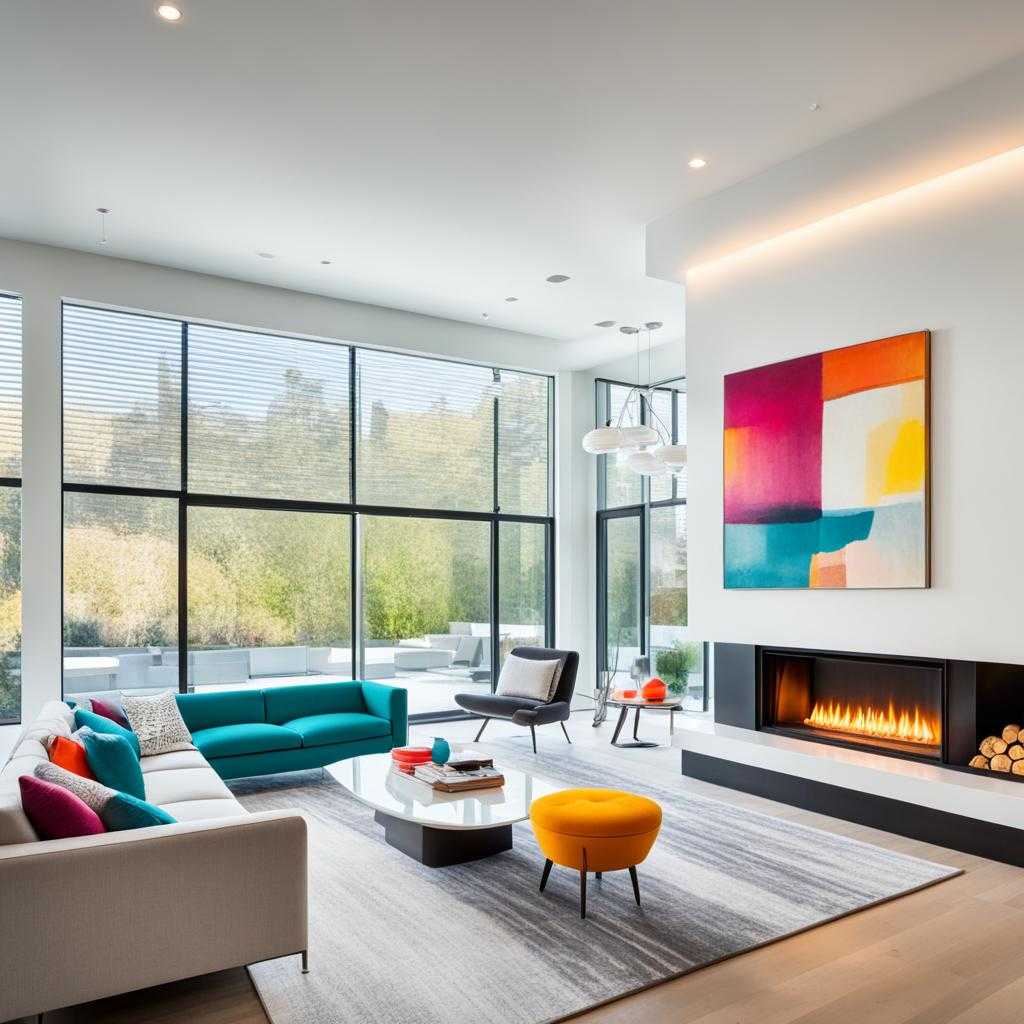
The mid-century modern style is known for its clean lines and focus on nature. It brought together form and function in a unique way. This style changed how people lived and looked at their homes.
Clean Lines and Minimalist Aesthetic
Mid-century modern design loves simplicity and hates clutter. Mid-century modern house features often have sleek shapes, flat roofs, and big windows. These elements let in lots of natural light, making rooms feel bigger and more open.
Connection with Nature and Outdoor Living
Mid-century modern architecture made indoor and outdoor spaces feel connected. Homes had big windows, sliding doors, and open layouts. Using natural materials like wood and stone helped bring the outdoors inside, creating a peaceful living space.
These mid-century modern design elements showed a love for nature and a desire for a simpler way of life. They encouraged people to enjoy the outdoors and live more casually.
“The ultimate goal of architecture is to create a paradise. Every house, every product of architecture… should be a fruit of our endeavor to build an earthly paradise for people.”
– Frank Lloyd Wright, renowned mid-century modern architect
Open Floor Plans and Indoor-Outdoor Integration
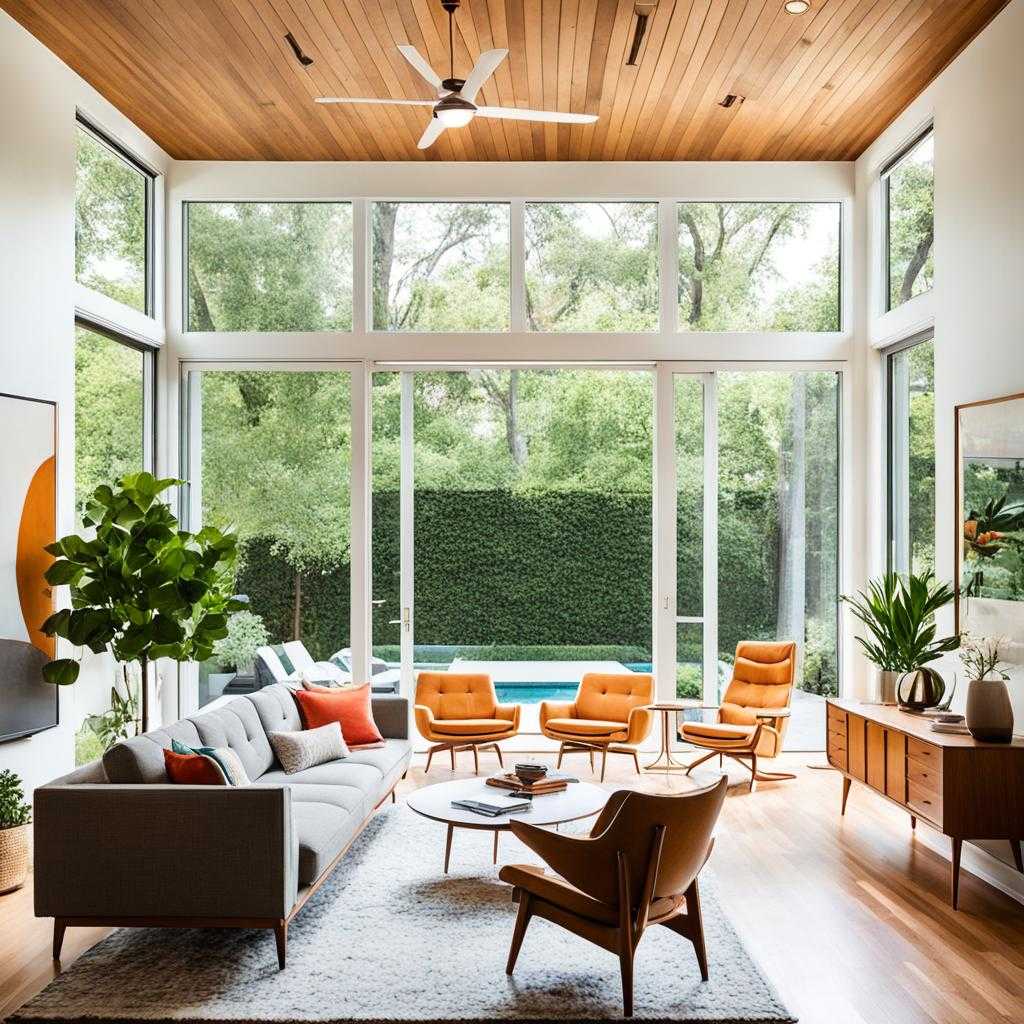
Mid century modern houses are known for their open floor plans. These designs make the living spaces feel bigger and more connected. Glass windows and doors help merge the inside with the outside. This approach is key to mid century modern architecture, linking the home to nature.
In mid century modern houses, the living, dining, and kitchen areas flow together smoothly. There are often no walls between them. This layout makes it easy for people to talk and move around, adding to the feeling of openness and light.
The style also focuses on mid century modern indoor outdoor living. Large windows, sliding glass doors, and glass walls connect the indoors with the outdoors. This lets homeowners enjoy nature while staying comfortable inside.
Connecting the home with the outdoors is both stylish and practical. The open layout and lots of natural light make the space feel larger and more airy. Being close to nature also improves air flow and energy efficiency in mid century modern houses.
The open floor plan and indoor-outdoor connection are key to the mid century modern look. They show the style’s focus on simplicity, usefulness, and living in harmony with nature.
Innovative Materials and Construction Techniques
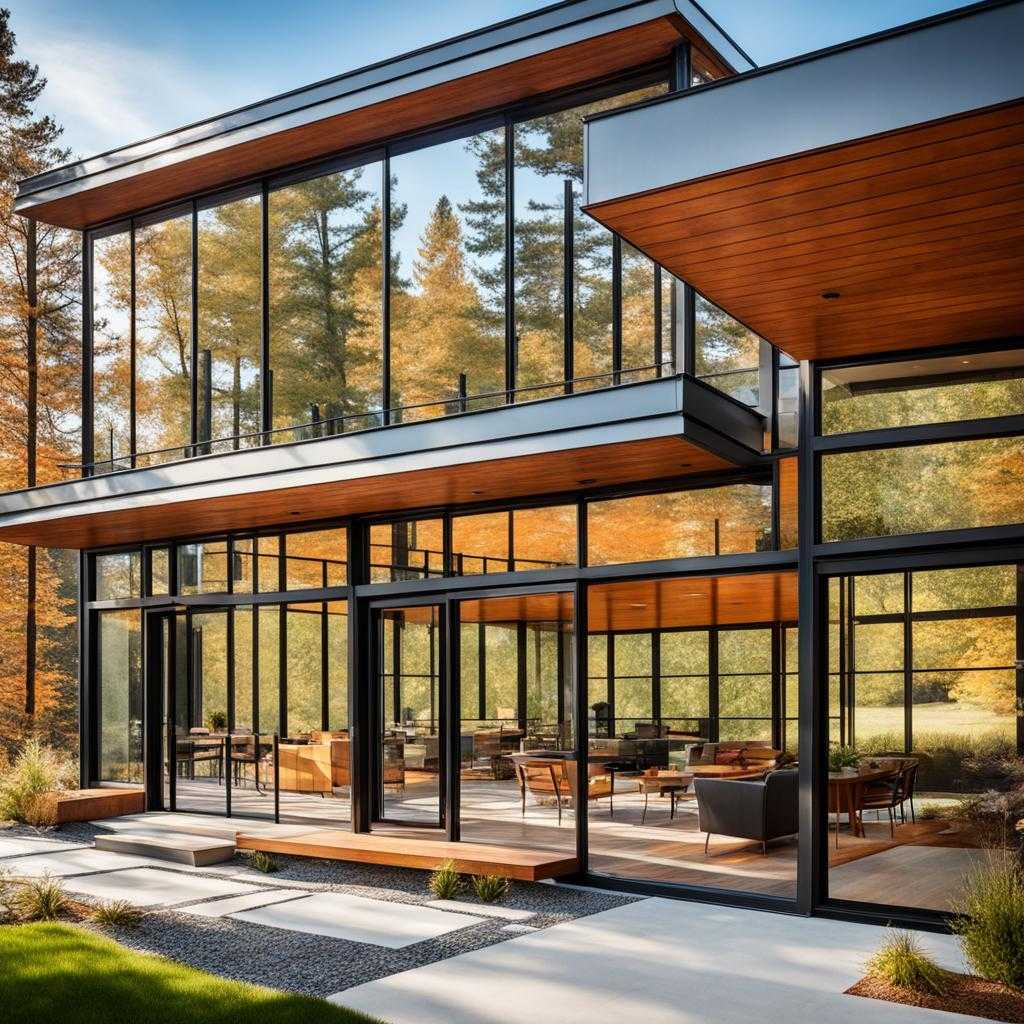
Mid-century modern architecture is famous for its creative use of materials and building methods. It featured sleek shapes and blended indoor and outdoor living areas. This was thanks to the smart use of steel, stone, timber, and glass.
Steel, Stone, Timber, and Glass
Architects of the mid-century era saw the potential in steel, stone, timber, and glass. They used these materials in new ways to change the look of buildings. Steel helped create the bold shapes that were a hallmark of the style. Glass walls and windows made rooms feel bigger by connecting indoors with outdoors. Timber and stone added a natural touch, fitting well with the focus on nature.
The mix of mid-century modern materials and construction techniques was key to the style. It let designers try new things in home building. This blend of beauty and practicality, along with a love for nature, led to some of the most famous houses of the mid-20th century.
| Material | Application in Mid-Century Modern Construction |
|---|---|
| Steel | Used for structural support, making bold, geometric shapes and open floor plans possible. |
| Stone | Added as a natural element that enhanced the connection to the outdoors. |
| Timber | Served both structural and decorative roles, adding warmth and a welcoming feel. |
| Glass | Glass walls and windows were used extensively to merge indoor and outdoor spaces. |
“The integration of modern materials and techniques was a defining characteristic of the mid-century modern aesthetic, enabling greater flexibility and experimentation in design.”
Functional and Uncluttered Interiors

Mid-century modern houses focus on functionality and simplicity. They follow the “less is more” design principle. This means clean lines, organic shapes, and no extra details in mid century modern interior design. The furniture and accessories are chosen for their simplicity and usefulness. The colors used also add to the clean look, making spaces both beautiful and practical.
Mid century modern decor blends indoor and outdoor spaces smoothly. Big windows, sliding glass doors, and natural materials like wood and stone connect the inside with the outside. Adding plants and natural patterns in the décor strengthens this connection with nature.
Mid-century modern design values functionality. It aims to use space well and keep things tidy. Built-in shelves and cabinets help with this. Furniture like sectional sofas and modular coffee tables are also chosen for their ability to serve more than one purpose.
| Design Element | Characteristic |
|---|---|
| Lighting | Minimalist, functional lighting fixtures, often featuring bold geometric shapes or exposed bulbs |
| Flooring | Hardwood, tile, or natural stone, with a focus on durable, low-maintenance materials |
| Wall Decor | Sparse, with an emphasis on artwork, mirrors, and subtle textural elements |
| Accessories | Purposeful, with a focus on organic forms and natural materials like wood, stone, and glass |
Mid-century modern interiors are simple, functional, and connected to nature. This design approach helps create spaces that look great and work well. It shows the lasting beauty of the mid-century modern style.
mid century modern house: Regional Variations

The core of mid century modern design stays the same across the U.S. But, it changes to fit local weather, landscapes, and cultures. In California, we see the Eichler homes. In the Pacific Northwest, there’s a unique take on the style. These show how mid century modern architecture varies by region.
California’s Eichler Homes
In California, Joseph Eichler’s homes are the essence of mid century modern. They have flat or low roofs, open layouts, and lots of glass. This makes the inside and outside feel connected. These homes show the California style, focusing on being simple, useful, and blending with nature.
Pacific Northwest Adaptations
The Pacific Northwest’s mid century modern homes follow the style’s main ideas. But, they adapt to the area’s rain and hills. They use sloped roofs, natural materials, and smart window placement for light and views.
Florida’s Tropical Flair
Florida’s mid century modern homes are made for the heat and humidity. They have big overhangs, large windows, and open areas for air flow. The use of tropical plants and materials like stucco makes these homes stand out.
Even with their differences, mid century modern homes share a common look. They focus on being simple, useful, and close to nature. By fitting to local conditions, these homes have become a lasting symbol of their places.
Mid-Century Modern Revival in Contemporary Architecture
The style of mid-century modern design is back in a big way, inspiring today’s builders and architects. They use the style’s timeless ideas but add a green twist. This means homes that look great and are good for the planet.
Sustainable Materials and Green Building Practices
Modern homes inspired by mid-century modern use eco-friendly materials and save energy. They use things like reclaimed wood and natural stone. They also have solar panels and insulation that saves energy.
This way, architects and designers update the mid-century look for today. They keep the style’s unique look but make it better for the environment. It’s a win for both the planet and design lovers.
- Reclaimed and recycled materials, such as timber and stone, minimize the environmental impact of construction.
- Energy-efficient windows, doors, and insulation help reduce the home’s carbon footprint and lower energy costs.
- Renewable energy sources, like solar panels, integrate seamlessly with mid-century modern design principles.
- Passive heating and cooling strategies, such as strategic window placement and natural ventilation, reduce the reliance on fossil fuel-powered systems.
Mid-century modern design meets green building in today’s homes. These homes keep the classic look but are better for the earth. They’re not just pretty; they’re also good for the planet.
“The mid-century modern revival in contemporary architecture is more than just a stylistic trend – it’s a conscious effort to marry iconic design with sustainable solutions for the future.”
Geographic Distribution and Popularity Centers
The mid century modern style shines in certain parts of the United States. It has won over homeowners and designers. From sunny mid century modern california to the green mid century modern pacific northwest, this style has made a big impact.
California: The Epicenter of Mid-Century Modern
California is the heart of mid century modern design. Its mild weather, stunning nature, and forward-thinking design make it perfect for this style. Mid century modern california homes are known for big glass walls, blending indoor and outdoor spaces, and using natural materials like wood and stone.
The Pacific Northwest: Embracing Nature
The mid century modern pacific northwest matches well with this style. Homes here have big windows, open layouts, and lots of timber. They show how buildings and nature can work together beautifully.
Florida: Adapting to a Subtropical Climate
While mid century modern california and the mid century modern pacific northwest are famous for this style, Florida has its own take. Here, mid century modern homes adjust to the warm weather. They use deep roofs, shaded areas, and materials like terrazzo to blend indoor and outdoor living.
| Region | Key Characteristics |
|---|---|
| Mid century modern california | Expansive glass walls, seamless indoor-outdoor integration, natural materials |
| Mid century modern pacific northwest | Large windows, open floor plans, prominent use of timber |
| Mid century modern florida | Deep overhanging roofs, shaded courtyards, use of terrazzo and stucco |
“The mid century modern style has found a natural home in regions that celebrate the great outdoors and embrace a harmonious relationship between the built environment and the natural world.”
Design Principles: Simplicity, Functionality, and Nature
The core of mid-century modern design is simplicity, functionality, and a bond with nature. This style is known for clean lines and minimal decor. It blends the built environment with nature smoothly.
Mid-century modern design focuses on simplicity. It avoids fancy decorations and extra details. Instead, it lets the beauty of materials and the structure speak for itself. This creates calm, clean living spaces that offer peace from daily life.
Functionality is key in mid-century modern design. Architects aimed to make homes beautiful yet practical. They designed open spaces, used lots of natural light, and connected indoor and outdoor areas. This makes the style practical and enjoyable.
Mid-century modern design also values a strong connection to nature. Large windows, sliding glass doors, and natural materials like wood and stone bring the outdoors in. This makes living spaces feel connected to nature, creating a peaceful environment.
These principles – simplicity, functionality, and nature connection – have made mid-century modern homes timeless. They are highly desired for their enduring beauty and practicality.
“The ultimate goal of architecture, like that of all the arts, is to create a paradise. Every house, every product of architecture… should be a fruit of our endeavor to build an earthly paradise for people.”
– Frank Lloyd Wright, renowned mid-century modern architect
Mid-Century Modern Furniture and Interior Design
The mid-century modern style goes beyond just the house’s design. It also includes furniture and interior design. Famous designers and artists greatly influenced the look of mid-century modern furniture and art.
Iconic Designers and Artists
Charles and Ray Eames, George Nelson, and Isamu Noguchi were key figures in mid-century modern design. They made a big impact with their mid century modern furniture and mid century modern interior design. Their work, known for its clean lines and focus on function, is still popular today.
“Simplicity is not the goal. It is the by-product of a good idea and modest expectations.” – Charles Eames
The Eames Lounge Chair, the Nelson Bench, and the Noguchi Coffee Table are famous pieces from this era. These items, along with many others, helped shape the mid century modern interior design look. This style is still very influential today.
| Designer | Iconic Pieces | Defining Characteristics |
|---|---|---|
| Charles and Ray Eames | Eames Lounge Chair, Eames Molded Plastic Chairs | Organic forms, plywood and fiberglass construction, focus on functionality |
| George Nelson | Nelson Bench, Nelson Ball Clock | Clean lines, geometric shapes, emphasis on simplicity |
| Isamu Noguchi | Noguchi Coffee Table, Akari Light Sculptures | Sculptural, organic forms, integration of natural materials |
Mid century modern furniture and mid century modern interior design are still loved today. This is thanks to the lasting influence of these famous designers and artists. Their work inspires and delights people, showing the lasting beauty of mid-century modern style.
Conclusion
The mid-century modern house has made a lasting impact on architecture and design. It’s known for its simple yet elegant style, blending well with nature. The era’s innovative materials and techniques have made it a favorite among many.
Today, mid-century modern design still inspires new creations. It combines old and new, using eco-friendly materials and green building methods. This approach makes spaces look great and helps the environment.
Mid-century modern homes are still popular everywhere, from California to Florida. They stand as symbols of a design era that changed architecture and design forever. Their beauty and timeless appeal keep them in the hearts of many.




